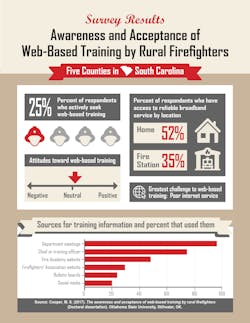Web-Based Training in the Rural Fire Service
A decade after the release of the iPhone, most would assume that nearly everyone has access to the Internet at any given time. Widespread access to mobile devices has helped encourage fire academies to implement the use of Web-based training. Because rural firefighters in remote areas have fewer training options than urban and suburban firefighters, agencies often view Web-based training as a way to bridge this gap. However, recent research from Oklahoma State University (OSU) suggests that some often-used Web-based delivery methods may not be the best option for providing supplemental training for firefighters in rural areas.
Study details
The OSU study sought to determine whether rural firefighters know about Web-based training and whether they use it. South Carolina, where the study took place, served as an ideal venue for the study because the state has a well-funded fire academy and an active firefighters’ association, and both organizations host online training resources on their own learning management systems. Most of the South Carolina Fire Academy’s (SCFA) Web-based offerings are self-paced courses that include video and other interactive multimedia content, although they offer a few courses as a combination of online and face-to-face sessions. The South Carolina State Firefighters’ Association (SCSFA) provides links to free and low-cost training materials, and it hosts content developed and shared by fire instructors and training officers. Before the study began, these two training providers assumed that most of their state’s rural firefighters were aware of their online offerings, but they had little data to support this belief.
The subjects of the study were predominantly volunteer firefighters who served departments in five rural counties in the state. These counties had experienced a relatively high number of fire-related deaths (as defined by a recent federal grant acquired by the SCSFA), and they met the U.S. Census Bureau’s definition of “rural.”
Firefighters completed a 50-item questionnaire during a department training meeting. The survey results showed the level of awareness of Web-based training among the participants was extremely low. While about 60 percent of participants reported taking at least one Web-based training course, only one in four said they actively seek Web-based training options.
Attitudes toward Web-based training were only slightly more favorable than unfavorable. These findings were not surprising, given that people who know little about Web-based training would likely express relatively neutral views toward it. The results also showed that the adoption of Web-based training appeared to have leveled off in 2015, although the snapshot nature of this study makes it difficult to confirm whether use has indeed reached its peak.
Possible barriers to Web-based training
Although the study did not seek to identify the specific barriers to the use of Web-based training, the results pointed to several possible contributing factors, such as:
- A lack of technology or Internet connectivity: Slightly more than half of respondents said they had access to reliable high-speed Internet at home. Firefighters who do not have access to high-speed Internet could be less inclined to seek information about Web-based training options.
- Limited spare time: Although Web-based training offers 24/7 convenience, given today’s busy lifestyles, volunteer firefighters may not have time to take Web-based courses.
- Preference for traditional training: Due to a lack of experience with self-directed learning, some firefighters may feel they learn better in a face-to-face environment.
- Ineffective marketing: In some cases, training agencies may not be using the best channels or the right message when advertising Web-based courses. Some firefighters also may choose not to participate in Web-based training if they believe their current level and frequency of training is sufficient.
Despite the study’s results, Web-based multimedia courses do indeed provide additional training options for firefighters. However, the majority of users may tend to live in urban and suburban areas, as media-rich courses require users to have a reliable high-speed Internet connection. Studies conducted in recent years by the Pew Research Center and other organizations have repeatedly shown that people in many rural areas in the United States do not have access to reliable broadband service. Having fewer local providers often results in customers paying higher costs for lower-quality Internet service, creating yet another barrier for potential users. Thus, this “digital divide” likely impedes the delivery of media-rich Web-based training for many rural firefighters.
Recommendations and reactions
Survey Results Infographic: Awareness and Acceptance of Web-Based Training by Rural Firefighters
Although online learners in remote areas face unique challenges in terms of connectivity, recommendations from this study do not suggest abandoning Web-based training delivery for rural firefighters. To the contrary, one important recommendation from this study is that, when targeting Web-based training for rural audiences, agencies should complement multimedia-based courses with additional resources that are less dependent on high-speed Internet. For example, such media could include audio podcasts (such as MP3 files) that firefighters can download and play at home or in the car while commuting. In addition, written transcripts of videos, along with still images captured from the video, enable learners to read the information on their own.
Additional strategies include training a few local firefighters as online learning experts, increasing the used of blended instruction, and “chunking” online course content into shorter learning modules, so that firefighters can participate in training when they have a few minutes to spare. As an added benefit, such changes increase accessibility for all firefighters, including those in urban and suburban areas.
For SCSFA staff members who helped facilitate data collection, some of the findings were surprising while others confirmed their suspicions. According to Rick Dunn, SCSFA’s training content manager and former training development director at SCFA: “In some areas of our state, not only are there few Internet service providers, but cell phone coverage may be spotty at best. The OSU research pointed out that many people in rural areas rely exclusively on their cell phone for Internet connectivity. Firefighters who do not own a desktop computer or a tablet may not be able to engage in an interactive multimedia course using their phone.”
Bryan Riebe, recruitment and retention coordinator for the SCSFA, noted that the study’s results could help guide the Association’s efforts to retain firefighters: “Volunteers who leave the fire service often say they simply don’t have time for training. Offering a wider variety of online resources, in addition to multimedia-based courses, may provide a part of the solution. Regardless, even relatively small changes to training delivery could go a long way in helping support the needs of rural firefighters.”
Both Dunn and Riebe agreed that training agencies might need to rethink strategies for marketing the availability of Web-based training. In South Carolina, both the Academy and the Firefighters’ Association advertise Web-based courses and other learning materials on their websites and through social media. However, the study showed that virtually all rural firefighters consider their department training meetings and their chief as the primary sources for information about training. “Just because a firefighter is on Facebook does not necessarily mean he or she will see one of our social media postings about online courses,” Dunn said.
Riebe agreed and added, “In addition to being aware of the availability of Web-based training, fire chiefs also need to be able to explain to others where to find it and how to access and use it. Training agencies need to ensure the chiefs have this information.”
In the future
On the positive side, the study’s results mean that Web-based training has a tremendous potential for growth among rural firefighters. To increase and retain their audience, Web-based training providers need to continue to recruit new users, develop new Web-based courses, and encourage existing users to retake courses as refresher training. Agencies also should train instructors on how to facilitate blended courses to help ensure students have a positive online learning experience.
The OSU study provided a foundation for much-needed research that focuses on training delivery methods for firefighters. While an increasing number of leaders in the fire service pursue graduate degrees, their academic interests are most often in areas such as emergency management, organizational leadership, or fire behavior and suppression, rather than instructional strategies. For this reason, these researchers hope to conduct follow-up studies in the future.
Reference
Cooper, M.S. (2017). The awareness and acceptance of web-based training by rural firefighters (doctoral dissertation). Oklahoma State University, Stillwater, OK.
Sidebar: Designing Web-Based Training for Rural Firefighters
Online training for rural firefighters may take on many forms, whether delivered using a traditional website or a learning management system (LMS). However, well-designed and affordable online instruction goes beyond posting static PDFs or other documents. At the same time, the use of digital technology does not have to exclude those learners who do not have a high-speed Internet connection or a computer. For example, although half of this study’s participants did not have access to broadband, the majority said they watched YouTube videos at least once a week. This suggests that using video streaming in Web-based training may enable more rural firefighters to participate. Many departments and training agencies have produced YouTube-based skills videos on a multitude of topics. While searching for resources to include, instructors need to judiciously choose videos that show the appropriate attention to detail and safety.
An ideal online module includes interactivity. People sometimes use the term “interactive” to describe media-rich, self-guided modules that require learners to navigate through the content on a computer by clicking course elements to reveal animations and popup windows. More often, the word “interactive” implies social interaction between the students and the instructor or among students. The most successful online courses create a sense of community. Interaction can take place in real time, using chat services or videoconferencing, or asynchronously through discussion forums, email or even Facebook.
A strategy for the development of a simple, low-cost and effective self-paced training module begins by determining the objectives of a lesson. The developer then creates new content or locates existing training materials to help learners fulfill each objective. The next steps include writing a sequential plan that tells how to complete each training activity, along with creating hyperlinks to the appropriate content. On average, learners should be able to complete a module in about 15 to 20 minutes.
Using this approach, a blended learning module on how to draft water from a static water source could resemble the following:
Objectives:
- Recall important safety considerations when deploying a tank and drafting from a static water source.
- Identify tools and equipment needed to complete drafting operations.
- List the procedures for drafting from a static water source.
- Demonstrate safe drafting operations.
Learning Plan:
- Read the Firehouse.com article “Rural Water Supply for Fire Suppression Is an Art.”
- Read the Drafting Operations Manual, which outlines the drafting operations, as well as important safety considerations.
- View the PowerPoint slides, which include photos that identify the necessary equipment and tools.
- Watch the YouTube video “Deploy a Portable Tank,” which demonstrates how to set up a tank for drafting. Review the video multiple times, if needed.
- Listen to the podcast “Basics of Drafting,” which briefly explains the science of drafting, where to position the truck, how to attach the hard sleeve, and how to start the pump.
- Using the online forum, discuss additional best practices for assembling and disassembling portable tanks at an emergency scene, based on your firsthand experience. Feel free to post questions or to answer questions posted by others.
- Test your knowledge by taking the online quiz.
- Review any information related to questions you may have missed.
- Practice safe drafting operations with other firefighters in your department.
Many useful resources exist that can help developers create effective online learning materials. For example, the Curriculum and Instructional Materials Center (CIMC) at the Oklahoma Department of Career and Technology Education offers a free book that includes detailed instructions on how to prepare self-paced learning modules for classroom or online use. This book can be downloaded at okcareer.tech/cbe. This competency-based approach to training development provides flexibility in that modules can be used for self-guided learning or blended learning (where learners complete skills training in person) or downloaded for use in instructor-led training in areas where Internet connectivity is a challenge for many department members.
About the Author

Dr. Margi Stone Cooper
Dr. Margi Stone Cooper serves as the digital delivery coordinator for the Oklahoma Department of Career and Technology Education.

Dr. Tutaleni Asino
Dr. Tutaleni I. Asino is an assistant professor of educational technology in the School of Educational Studies at Oklahoma State University.
